From the “Muppets Treasure Island” 1996.
Thanks to Cynthia Drew for daring me to post it.

From the “Muppets Treasure Island” 1996.
Thanks to Cynthia Drew for daring me to post it.
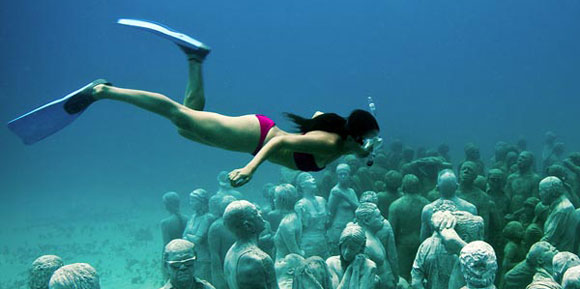 Snorkelers and divers swimming south of Isla Mujeres and off Punta Nizuc off Cancun will now find themselves in a monumental underwater sculpture garden of life-sized human statues rising up from the sandy bottom in crystal tropical clear waters. The 450 sculptures are the work of British artist Jason deCaires Taylor and are part of MUSA (Museo Subacuático de Arte,) a vast underwater museum in the in the waters surrounding Cancun, Isla Mujeres and Punta Nizuc.
Snorkelers and divers swimming south of Isla Mujeres and off Punta Nizuc off Cancun will now find themselves in a monumental underwater sculpture garden of life-sized human statues rising up from the sandy bottom in crystal tropical clear waters. The 450 sculptures are the work of British artist Jason deCaires Taylor and are part of MUSA (Museo Subacuático de Arte,) a vast underwater museum in the in the waters surrounding Cancun, Isla Mujeres and Punta Nizuc.
The Great Mayan Reef is the second largest barrier reef in the world. In addition to being threatened by pollution, over-fishing and ocean warming, the reef is also threatened by its popularity. The section of the reef adjacent to the resort islands of Cancun and Isla Mujeres attracts 750,000 people each year. One of the stated objective of the museum is to take pressure off the natural reef by drawing visitors to the sculpture reef.
The plan for a new artificial reef was wonderful, and beautifully executed until the very last minute. Artist Chris Wojcik had constructed a 47-foot-long, 25,000-pound concrete sculpture of a horseshoe crab, which was welded to two barges and was to be sunk in the Atlantic off the New Jersey shore as a new artificial reef, providing both a new habitat for sea life and a destination for recreational divers. The project was dubbed “Art as Reef.” (See our previous post here.)
The crab sculpture was towed out to the reef site in the Atlantic on Axel Carlson Reef, in 80 feet of water, 4.4 miles from the Manasquan Inlet.. The plan was to flood the barges while stabilizing them with straps from a crane barge to ensure that the barges sank on an even keel. Everything went well until the after crane strap broke. Instead of a level sinking, the barge dove unexpectedly, cracking and crushing the concrete sculpture. As reported by the Asbury Park Press: “It’s cut in pieces and unrecognizable,” artist Chris Wojcik said early Friday morning, after making dives Thursday on the artificial reef structure intended to be the sculpture’s home. “I’m devastated, is a pretty accurate way to put it,” Wojcik said.
While it may not be the work of art intended, the broken crab and barge will still serve as an artificial reef, providing an new habitat for marine life.

Armstrong from 1969
Neil Armstrong, the first man to set foot on the moon, best known for navigating the Sea of Tranquility, began his career as a Navy aviator. Armstrong, who died on August 25, at the age of 82, will be buried at sea as per his wishes. NASA has scheduled a public memorial service to be held Sept. 13 at Washington National Cathedral. No date has been set for the burial at sea which will be performed by the US Navy.
Neil Armstrong, who stood on moon’s Sea of Tranquility, to be buried at sea

Photo: Intermarine
On August 29, the multipurpose US flag cargo ship, M/V Ocean Atlas, arrived in Maracaibo, Venezuela. Not long after, the ship was detained by Venezuelan security forces and was repeatedly searched by agents from Interpol and the Venezuelan drug enforcement agency, reportedly based on a tip that illegal drugs were being carried aboard the ship. When no drugs were apparently found, the Venezuelan authorities arrested the captain of the ship on charges of arms trafficking, after finding three rifles on board. The rifles were apparently listed in the ship’s manifest. The US crew were initially detained aboard, though there are reports that warrants have been issued for their arrest as well and that some or all have been taken ashore for questioning.
 Sad news. Dr. Edmund ‘Ned’ Cabot, 69, a retired surgeon and a lifelong sailor, drowned on Saturday off the coast of Newfoundland when his sloop Cielita was knocked down by a “rogue wave” and he was lost overboard.
Sad news. Dr. Edmund ‘Ned’ Cabot, 69, a retired surgeon and a lifelong sailor, drowned on Saturday off the coast of Newfoundland when his sloop Cielita was knocked down by a “rogue wave” and he was lost overboard.
Edmund ‘Ned’ Cabot, Boston Brahmin scion and avid yachtsman, drowns off Newfoundland
Cabot and his two friends set out along the Newfoundland coast in winds that neared gale force Saturday morning, Ellis said, and the winds increased during the day. Ellis said that from what he understood, around midday, with winds coming from the rear of the boat from about a 45-degree angle, Cabot came from below deck to relieve the helmsman. A wave struck with such force that the boat was knocked on its side, spilling Cabot and the helmsman into the water.
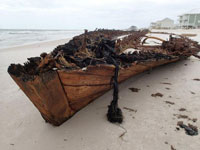
Schooner Rachel makes another appearance Photo: MEYER VACATION RENTALS
The first reports spoke of a “mystery shipwreck” uncovered by Hurricane Isaac on an Alabama beach about six miles from Fort Morgan. It turns out the wooden vessel is not so mysterious after all. Local historians identified her as the 150 feet long, three masted, lumber schooner Rachel built in 1918, which came ashore in a storm in 1923. This is not even the first time that the wreck has made an appearance. She was also uncovered from beneath the beach by Hurricane Camille in 1969, then again in 2004 after Hurricane Ivan, and again in 2008 after Hurricane Ike. The only thing mysterious about the schooner is her cargo on the night of her demise. Legend has it that she was carrying bootleg alcohol instead of lumber when she ran aground during the Prohibition.
The sea ice in the Arctic has melted to a record low this year. Yachts are not voyaging where once only large icebreakers could travel. Recently, the three man crew of the Belzebub II, a 1976 built Hallberg-Rassy Monsun 31 sloop, successfully completed a three month transit of the fabled Canadian Northwest Passage, including becoming the first sailboat to cross the infamous M’Clure strait, which normally would be icebound. From the expedition web site:
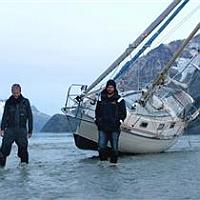
Photo: Belzebub II crew
“The Arctic is melting at an alarming rate and is clear proof of our disharmony with the planet. By sailing this newly opened route we hope that our expedition will play a small part in bringing further attention to climate change and contributing to a larger shift in attitudes. Our approach to sail across a historical stretch of water that has traditionally been frozen is meant to be a clear visual example of the extent of declining polar ice.”
The 20th Annual Great North River Tugboat Race & Competition was again a great success. For full and complete coverage check out Will’s Tugster blog. Great photographs and commentary.
For those in the area who still haven’t had your fill of tugboats, you may want to head upriver to Waterford, NY. for the 2012 Waterford Tugboat Roundup. Waterford is 12 miles north of Albany at the junction of the Hudson and Mohawk Rivers, and the junction of the Erie and Champlain Canals. It is the home of the “Waterford Flight”, the highest set of lift locks in the world. Almost every year since 1999, the town of Waterford and the Waterford Maritime Historical Society has hosted the roundup, attracting tugs from all over the region. Last year the roundup was canceled due to the arrival of Hurricane Irene, but this year it is back and promising to be one of the best ever. The festivities are held from Friday to Sunday, September 7th – 9th.
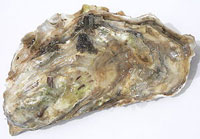
Hero or criminal?
Recently a number of newspapers have run an Associated Press article titled, “New York’s new environmental ‘hero’ – the oyster.” The article describes how researchers are reseeding oysters in New York harbor Each oyster can filter about 50 gallons of water a day, removing toxins and suspended silt from the water. The oysters may play a big role in cleaning up America’s polluted urban maritime environment. The Oyster Restoration Research Partnership and others have begun seeding new oyster beds at Hastings On Hudson, Soundview Park, Governors Island, Bay Ridge Flats, the Bronx River, Gowanus Canal and Staten Island. High school student’s at New York’s Harbor School are cultivating oysters for academic credit.
The one place that you will not find new oyster cultivation in New York harbor is on the New Jersey side. The border between the two states runs right down the center of the Hudson River. While New Yorkers are working to reestablish the “environmental hero,” on their side of the harbor, oysters are criminals on the New Jersey side. Well, not the oysters themselves, but anyone doing oyster research. Under Governor Chris Christie, New Jersey banned oyster restoration in 2010 in waters classified as contaminated for shellfish, citing public health concerns. The research oyster beds that existed in New Jersey were shut down. From the NY/NJ Baykeeper web site:
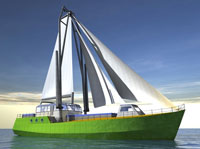 The Greenheart Project is now raising money to build a 32 meter sailing cargo ship for small ports and lesser developed countries. The design is extremely impressive. It is low-cost, has zero-emissions and is also efficient to load and unload. Cargo operations may seem a touch prosaic as compared to sails and sailing, but the truth is if you can’t load and unload a ship quickly and efficiently, it is very difficult to make the economics work.
The Greenheart Project is now raising money to build a 32 meter sailing cargo ship for small ports and lesser developed countries. The design is extremely impressive. It is low-cost, has zero-emissions and is also efficient to load and unload. Cargo operations may seem a touch prosaic as compared to sails and sailing, but the truth is if you can’t load and unload a ship quickly and efficiently, it is very difficult to make the economics work.
 Alaric Bond’s The Patriot’s Fate, the fifth in his Fighting Sail series, is an exciting nautical adventure that is also a rich and fascinating voyage through the history, politics and complex divided loyalties of Britain at the end of the eighteenth century.
Alaric Bond’s The Patriot’s Fate, the fifth in his Fighting Sail series, is an exciting nautical adventure that is also a rich and fascinating voyage through the history, politics and complex divided loyalties of Britain at the end of the eighteenth century.
Many novels in the genre follow the model used by C.S. Forester, Patrick O’Brian and so many others, where the focus is the career of a single Royal Navy officer. The Patriot’s Fate, like the other books in Bond’s Fighting Sail series, is told through multiple perspectives, ranging from the ship’s captain, to the junior officers and warrants, to Jack Tars and the ship’s boys. The approach gives a much broader sense of what is going on aboard ship. It works particularly well in The Patriot’s Fate because it allows parallel and overlapping story lines that keep the novel moving along briskly.
 Two great schooner festivals and regattas are now underway on Massachusetts’ Cape Ann and Cape Cod. On Cape Ann, the Twenty-Eighth Annual Gloucester Schooner Festival began yesterday with the arrival of the schooner fleet. Today there will be dockside events and tours of the visiting HMS Bounty. The Mayor’s Race will be sailed on Sunday with Monday held in reserve as a rain day.
Two great schooner festivals and regattas are now underway on Massachusetts’ Cape Ann and Cape Cod. On Cape Ann, the Twenty-Eighth Annual Gloucester Schooner Festival began yesterday with the arrival of the schooner fleet. Today there will be dockside events and tours of the visiting HMS Bounty. The Mayor’s Race will be sailed on Sunday with Monday held in reserve as a rain day.
Just to the south on Cape Cod, the Great Provincetown Schooner Regatta begins today and runs through Friday, September 7th. The week long festivities on land and sea include racing in and around the waters of Provincetown Harbor and the Fisherman’s Cup race, a schooner only event, which starts in Gloucester on Tuesday, September 3rd and ends in Provincetown harbor.
 The 20th Annual Great North River Tugboat Race and Competition will be held again this year on the Hudson River at Pier 84 (off W44th Street) in Manhattan. The festivities begin with a Parade of Tugs at 10:00 am with the tug boat race, from the 79th Street Boat Basin to Pier 84, starting at 10:30. Good views of the race are available from the dock. A special Circle Line Spectator Boat also provides a great view of the race and the parade of tugs. Following the race, there will be line throwing competitions and nose-to-nose pushing competitions between the tugs. If you are anywhere near New York harbor on Sunday, it is worth stopping by. The event is sponsored by the Working Harbor Committee.
The 20th Annual Great North River Tugboat Race and Competition will be held again this year on the Hudson River at Pier 84 (off W44th Street) in Manhattan. The festivities begin with a Parade of Tugs at 10:00 am with the tug boat race, from the 79th Street Boat Basin to Pier 84, starting at 10:30. Good views of the race are available from the dock. A special Circle Line Spectator Boat also provides a great view of the race and the parade of tugs. Following the race, there will be line throwing competitions and nose-to-nose pushing competitions between the tugs. If you are anywhere near New York harbor on Sunday, it is worth stopping by. The event is sponsored by the Working Harbor Committee.
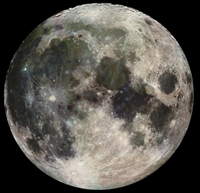 Tonight’s sky will be graced by a “blue moon.” It is the first blue moon since New Year’s Eve 2009. The next blue moon won’t appear until July 2015. Tonight’s full moon won’t actually be blue for most of us. A “blue moon” is commonly defined as the second full moon in a calendar month. It doesn’t happen often and so is the inspiration for the phrase, “once in a blue moon.”
Tonight’s sky will be graced by a “blue moon.” It is the first blue moon since New Year’s Eve 2009. The next blue moon won’t appear until July 2015. Tonight’s full moon won’t actually be blue for most of us. A “blue moon” is commonly defined as the second full moon in a calendar month. It doesn’t happen often and so is the inspiration for the phrase, “once in a blue moon.”
It is possible that there may be a literally blue moon for some. Ash in the atmosphere from forest fires or volcanic eruptions can make the moon appear to be tinted blue. There are a sufficient number of forest and brush fires in parts of the United States resulting from recent drought conditions so that tonight’s moon may be blue in both senses.
 Linda Collison’s recently released “Barbados Bound,” begins provocatively, “I came aboard with the prostitutes the night before the ship set sail.”
Linda Collison’s recently released “Barbados Bound,” begins provocatively, “I came aboard with the prostitutes the night before the ship set sail.”
The year is 1760 and not yet 17 year old Patricia Kelley is, quite literally, seeking to find her place in the world. The illegitimate daughter of a West Indies plantation owner, attending an English boarding school, she finds herself without money, family or connections when her father dies suddenly. With a head full of dreams of reclaiming the plantation where she was born and largely raised, that her father promised to her as a dowry, she stows away aboard a merchant ship carrying gunpowder and military stores, bound for Barbados. She has much to learn of the world and her education is just beginning.
A wonderful story about private citizens in their own small boats in Plaquemines Parish, Louisiana, who came the rescue of their neighbors during Hurricane Isaac, guided by often by information from Facebook, earning the nickname, the ‘Cajun navy.’
 Tomorrow, Friday August 31 through Monday September 3, 2012, the Maritime Museum of San Diego will host the Festival of Sail 2012, the largest tall ship festival on the west coast, transforming San Diego’s North Embarcadero into a nautical theme park. More than twenty tall ships and other fascinating vessels will be participating. The festivities start this afternoon with a parade of ships around San Diego bay finally ending at the Maritime Museum’s docks.
Tomorrow, Friday August 31 through Monday September 3, 2012, the Maritime Museum of San Diego will host the Festival of Sail 2012, the largest tall ship festival on the west coast, transforming San Diego’s North Embarcadero into a nautical theme park. More than twenty tall ships and other fascinating vessels will be participating. The festivities start this afternoon with a parade of ships around San Diego bay finally ending at the Maritime Museum’s docks.
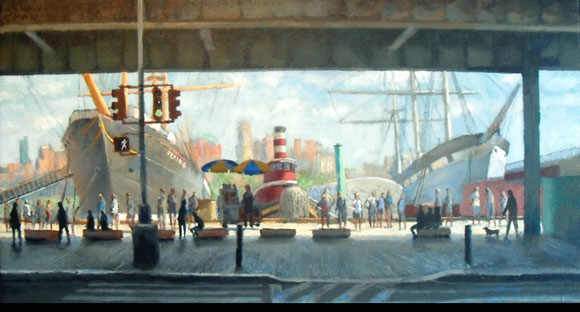 If you are near New York harbor, there is a closing party for the “Ships of New York Harbor: Marine Art of Christina Sun and Frank Hanavan” exhibit on the historic lighthouse tender Lilac tomorrow evening September 30, from 6 to 10 PM at Pier 25 on the Hudson River at West Street and N. Moore Street in lower Manhattan. There will be music by the Jug Addicts, a five-piece band playing music in the style of 1930s and 1940s “jug” bands, combining elements of ragtime, swing, and folk music. David Sharps of the Waterfront Museum will serve as auctioneer at 8:30 PM when selected works by Frank and Christina and photographers Shelley Seccombe and David Hodgson are auctioned to benefit the restoration of the Lilac.
If you are near New York harbor, there is a closing party for the “Ships of New York Harbor: Marine Art of Christina Sun and Frank Hanavan” exhibit on the historic lighthouse tender Lilac tomorrow evening September 30, from 6 to 10 PM at Pier 25 on the Hudson River at West Street and N. Moore Street in lower Manhattan. There will be music by the Jug Addicts, a five-piece band playing music in the style of 1930s and 1940s “jug” bands, combining elements of ragtime, swing, and folk music. David Sharps of the Waterfront Museum will serve as auctioneer at 8:30 PM when selected works by Frank and Christina and photographers Shelley Seccombe and David Hodgson are auctioned to benefit the restoration of the Lilac.
One hell of a day for storms at sea. Just after noon today, Isaac was upgraded to a Category 1 hurricane as it slowly moved north in the Gulf of Mexico toward Louisiana and the city of New Orleans, on a track disturbingly similar to that taken by Hurricane Katrina seven years ago, which came ashore as Category 3 hurricane.
In the Pacific, Typhoon Bolaven is pounding the Korean peninsula. Five Chinese crew are confirmed drowned and twelve are still missing from two Chinese fishing vessels off Jeju Island, near the southern tip of the South Korean mainland.
South Korea typhoon kills Chinese fishermen
Thanks to Phil Leon for contributing to this post.